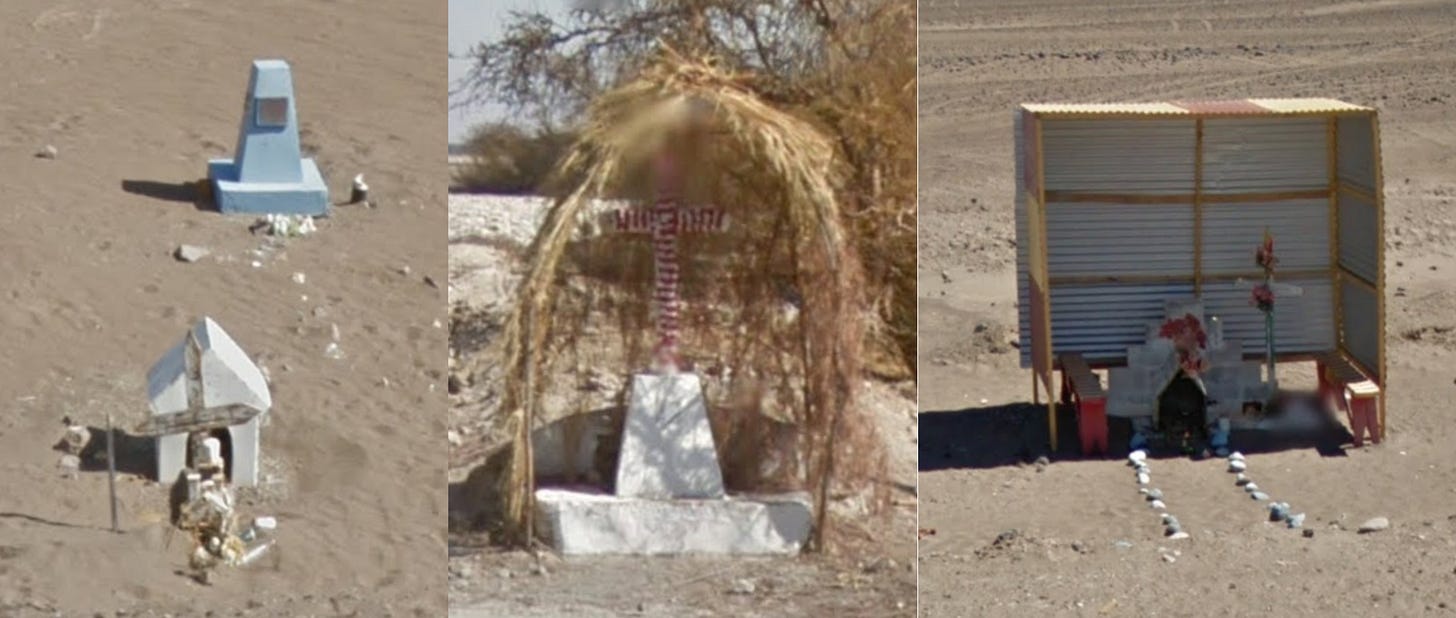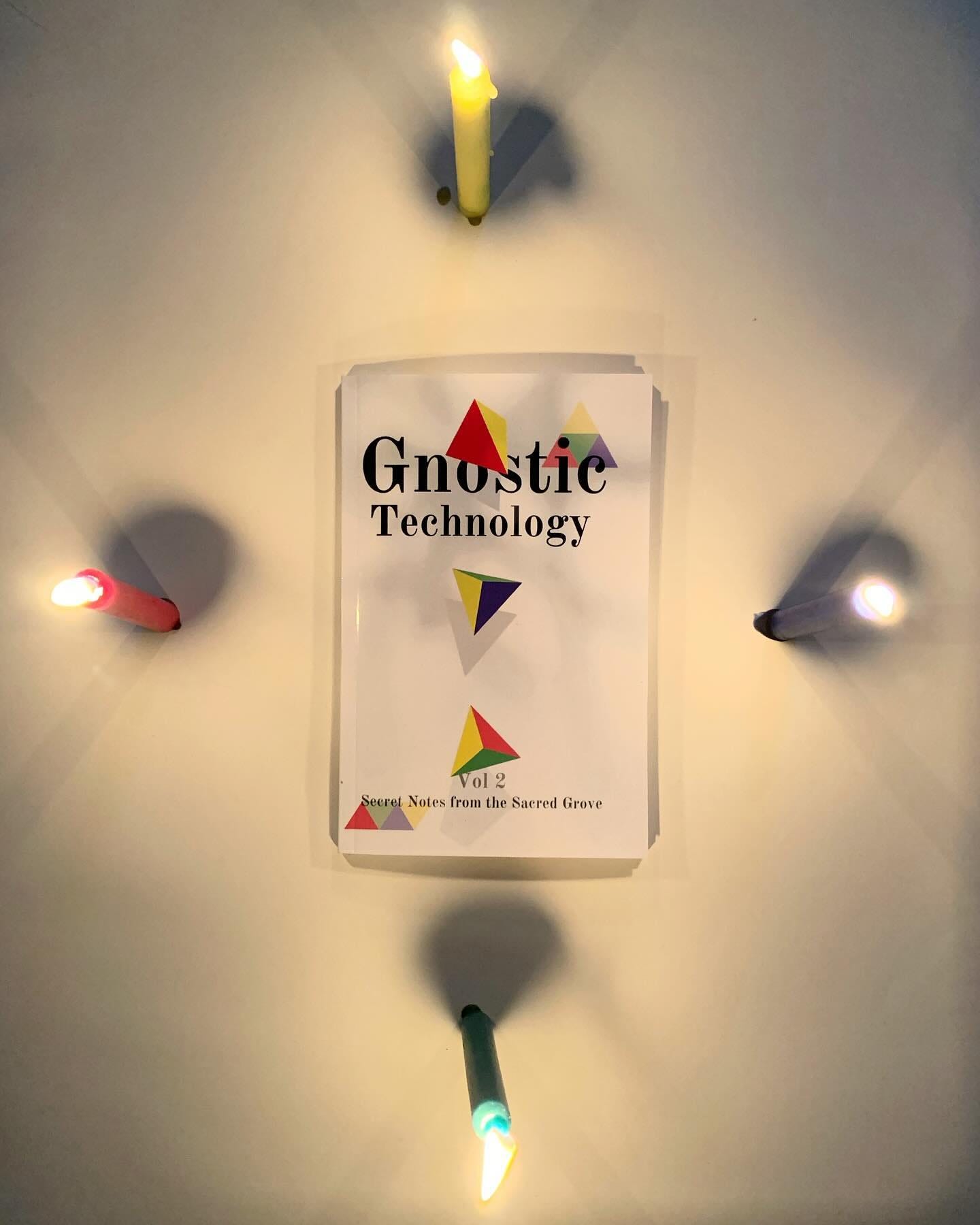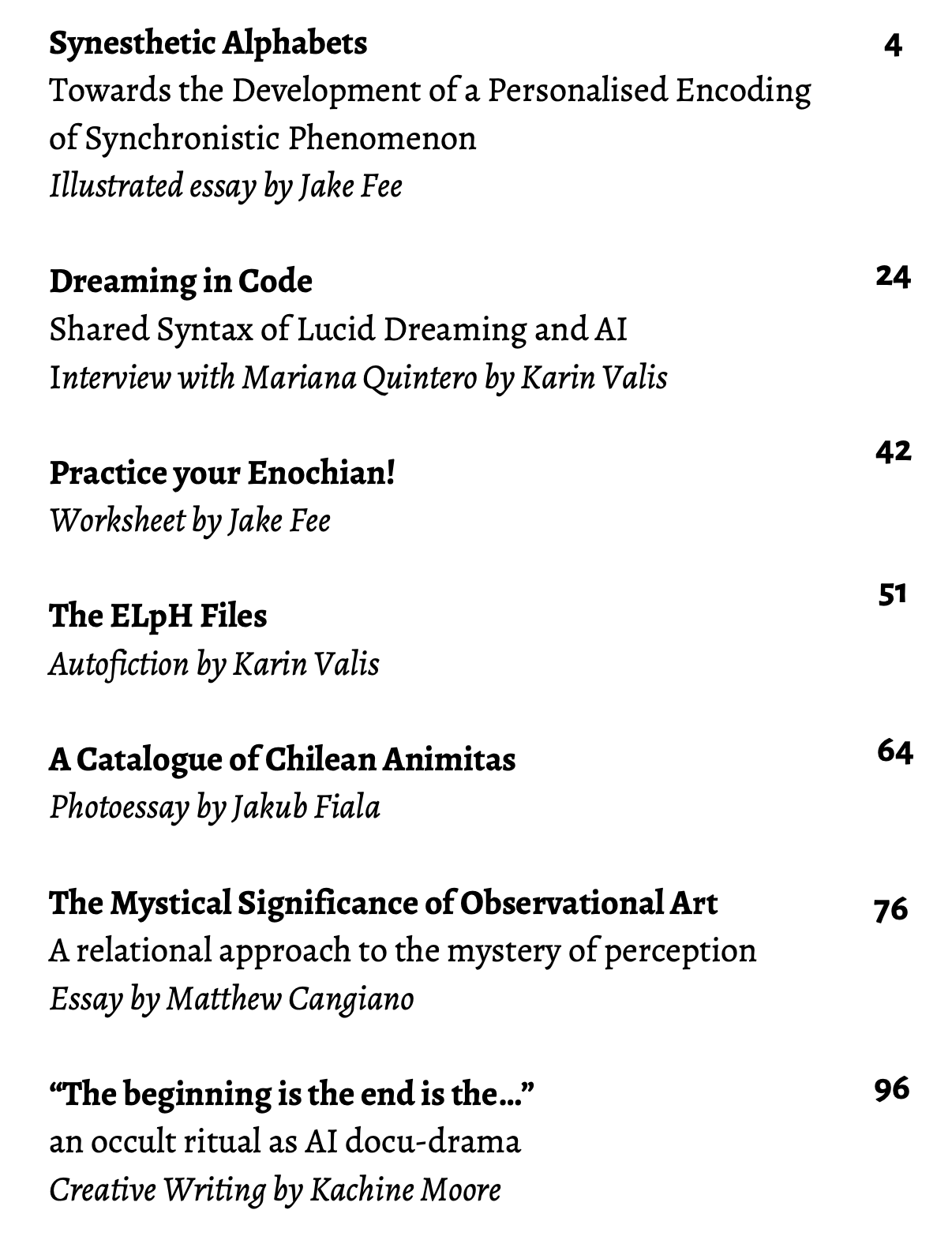Finding Gustavo
Street View Pilgrimage through Chilean Animitas
Dear friends,
I realised I really don’t want to miss the last Mercurial Minutes of 2024! So on this dark solstice day, I would like to share with you an interview with my long-term collaborator in all things weird, Jakub Fiala and his wonderful new project Finding Gustavo, a meditative game built within Google Street View.
Jakub is a Berlin-based artist and creative technologist, specialising in algorithmic, sonic and interactive art. He particularly enjoys misusing technology to unveil the Realm of the Weird; exposing the machines' delicate innards and making them tell human stories. We have quite a history of mischief in the digital and physical spaces alike, to name just a few - a fake Silicon Valley startup, Tarot of the Latent Spaces and we even released a Burroughsian conspiracy punk tape Pancreas Denail (our live shows featured Jakub in a priest robe and I harmonising: Hey you, don’t call me sheeple, I know that Soylent Green is people. To the true wisdom, I aspire, I’m gonna burn that 5G toooo-wer)
Anyway, you know what I mean. In this interview, I would like to discuss his latest project Finding Gustavo and explore the themes of world-building, sacred digital spaces, and the eerie beauty of roadside shrines in Chile.
Interview
> So Jakub, what brought you to this devotional project for Gustavo? What is it all about?
Back in 2019 I was playing around with a piece of software we’d built with Tim Cowlishaw, which let us embed localised sounds into Google Street View. I was interested in the uncanny feeling when a soundscape is added to Street View’s still, 360-degree images. I got bored of “walking around” my London neighbourhood, so I grabbed the little yellow figure and dropped it blindly onto somewhere in northern Chile.
I was presented with an arid flatland, cut in half by an endlessly long road. As I walked through this moonscape, I began noticing shrines on the roadside - not the simple crosses found throughout Europe, but large whimsical constructions with shelters, solar-powered lights, repurposed car parts and a wide variety of architectural styles. They were animitas (Spanish for “little souls”) - memorials to victims of traffic accidents. I started collecting screenshots and became more and more mesmerised with the diversity and creativity of these solemn places. I gathered my folder of screenshots, life happened, and I would not revisit the desert for another five years.
> How did this turn into a game?
This year I got invited to an artist residency at Domestic Data Streamers in Barcelona. The theme of the residency was “New Data Languages”. I decided to revisit the old code that let me explore the Chilean desert and see if I can use Street View as a sort of game engine, including sound, 3D objects and interactions.
One of my biggest inspirations was Dear Esther - an old game which started as a free mod of Valve’s Source engine. In this game, the player appears on a barren British island, exploring its many valleys and caves. There is no fighting, no inventory, no collecting coins along the way. You walk, you look and you listen to the narrator’s heart-wrenching story.
In my art practice I like to mis-use existing technologies and use them to create meaningful encounters with humanity. I find our current experience of the Internet rather too fast and compartmentalised - media formats such as Instagram reels make it very hard to attend to things, to freely explore, let things ooze from one box into another. I wanted to craft a space where one can move slowly, practice deep listening, notice details; achieve a state of consciousness similar to reading a long, rich novel.
> The shrines you have encountered in Street View are deeply personal and magically charged places. Did you ever feel like the act of digitally exploring them revealed something sacred—or transgressive—about using technology in this way? Did you have any particular moments during your explorations where you felt like you were experiencing something uncanny or weird?
Certainly! Investigating the animitas, at times I could read the inscriptions including the victims’ names. It felt so intimate - I saw myself a kind of voyeur, peeking through the Veil and reaching a stranger’s resting place across the planet. It became even eerier as I began to write the game’s storyline, using the landscape (including the local animitas) as a scaffolding. I found myself in dialogue with this distant world; I would insert a piece of the story, enter Street View and anxiously wait to see if the world accepts it… at times it wouldn’t. Likewise, the world would present me with signals and suggestions - e.g. an animita inscribed with a plea for water - which turned into subplots or entire chapters of the story.
Just as I was about to finish the game, my partner played through the first chapter, the boring road I had walked hundreds of times, and noticed the ruins of a house among some bushes on the roadside. On the wall, sprayed in bright white, stood my surname. It was as if the world revealed itself to me, a slow nod mediated through cameras, hard drives, data centres and undersea cables, 12 years since the Google car passed down that road.
> Do you think this project could be seen as a form of pilgrimage, a digital one? What does it mean to undertake a pilgrimage in a virtual space?
I think there is a sort of Gnostic duality in how the Internet affects things. On the one hand, one could say the concept of a pilgrimage has been automated away. Experiencing different places in profound ways has never been easier. I truly believe interfaces like Street View are a form of remote viewing - not just literally, but in the ESP sense. If we can swarm upon the cathedral in Santiago de Compostela without the hassle of a 800km trek, why shouldn’t we? Why should enlightenment through pilgrimage only pertain to the able-bodied and well-traveled?
Yet as the Internet stripped away much of the mystique pilgrimages possessed in earlier times, it’s itself become rife with unexplored territories. It’s a thread running through the occult work we’ve done together, too - what’s hiding between the pre-defined boxes of digital interfaces? What happens when we ramble in a direction that wasn’t prescribed to us by the Silicon Valley overlords? Use a cheat code here, glitch through the texture there… I think there is space for challenging, exhausting, epic pilgrimages on the Internet. Perhaps the only thing we need is another kind of cathedral - a radical goal to strive for, a shared vision we can rally around.
> You mentioned crafting a space where people can “move slowly” and “practice deep listening.” Attention is inherently linked with mystical practices. Yet, technology often seems to encourage the exact opposite, speed and distraction. Do you see any emerging trends in technology that support slowness and deeper attention, countering this tendency?
I feel like every time a new technology appears and makes something faster (and more profitable) sooner or later there is a quiet countermovement which uses the same technology, but rejects the intended effect. Like when YouTube got big and you were supposed to watch lots of videos with ads in between - people started uploading ten-hour videos of lo-fi music over an animated loop, and putting them on as background sound. The recent shift from open-field social media to smaller communities on Discord (which was intended to be a gaming chat platform) or the “digital gardens” movement are also good examples.
It’s not yet clear to me how this will play out with the impactful new technologies of today - e.g. LLMs & other transformers, the tiktok video format. As is often the case, the trends are being set on the fringe - and the work you have been doing with AI models and ESP seems to be exactly the kind of practice that could take the technology beyond its intended “just tell me the answer” function.
> Thank you Jakub, this was a wonderful conversation. I’m halfway through the adventure now, so I’ll jump back in. Just one last question: what’s your favourite animita?
The animita I would nominate for the #1 shrine in the Tarapacá region (where Finding Gustavo takes place) would be the one found at 20°24'12.3"S 69°37'38.1"W, consisting of a purpose-built enclosure with cross-shaped openings, a martyr-like doll nailed to a wooden cross, and prolific use of Coca-Cola merchandise. I love the raw honesty of using Coke as a spiritual object - in Mexico, they use it as a healing salve and there’s even a dedicated Coca-Cola church. If so much of our world is determined by these big brands, we might as well plaster ourselves with advertising and douse ourselves in soda - the power is in the how, not the what.
✞✞✞
Finding Gustavo is available here as an online experience. All you need is a web browser and a pair of headphones.
‘24 Breadcrumbs
Thoth Hermes s11e3 with Eric Wargo
I really enjoyed the conversation with Eric Wargo a few weeks back for the Thoth-Hermes Podcast. We chat about the long self, HGA, free will, synchronicities, retro-causality, and you know… the usual hot topics for a night in a smokey bar! Give it a spin and let me know what you think :)
The next episode with Dr. Dean Radin is unfortunately delayed for a few days, but from January we’re back on track with more really exciting guests.
Gnostic Technology Zine is Out!
And you can purchase it through any of the cursed Amazon locales here! We’re super happy about this volume, you can look forward to some great essays, stories, interviews, colouring sheets, and even … a bingo!
And if you’re still wondering what to grab as a Christmas present for your weird auntie of yourself, check out Alphachar’s course on how to write for video games!
Orrrr get some of Anna Sebastians’s gorgeous sketches. This one you CAN’T HAVE IS MINE hehehe.
Hope the festive season treats you kindly, and that you’ll be ready to pour all that’s desired into the new year.
Stay sweet,
k











Nice post, "one could say the concept of a pilgrimage has been automated away", that's quite profound, also Dear Esther was/is a great game!
All the best for 2025 friend